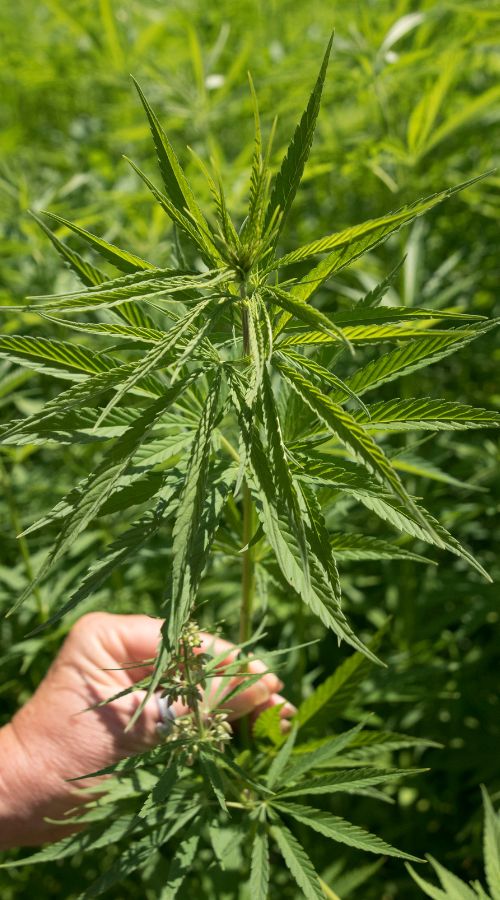STORE INFO
Location & Store Hoursmy cart
Secure checkout
Hemp is grown for clothing, rope, and even seed. But it also has a flower rich in cannabinoids that is used for CBD products.
But there are differences between industrial and high-resin hemp.
How the hemp is cultivated and what it’s intended for is what separates industrial hemp and high-resin hemp. Here’s what you should know.

Industrial hemp is a type of hemp grown with utility in mind.
By legal definition, in the United States and based on the Farm Bill, it must contain less than or equal to 0.3% THC. That distinction means it can be cultivated and sold legally for non-intoxicating purposes.
So, what is industrial hemp used for?
Farmers grow it for strong stalks that can be turned into fiber for textiles, rope, and paper. The seeds of the plant are pressed for oil that is used in cosmetics and as food. Its fiber is being developed into bioplastics, sustainable composites and hempcrete, a material made from the inner core of the stalk, that is used as an eco-friendly alternative to traditional concrete and insulation.
Unlike varieties bred for high resin hemp flowers, industrial hemp plants don’t produce dense buds. They’re tall and sturdy, cultivated in large fields where the focus is on quantity.
High resin hemp or CBD hemp, on the other hand, is cultivated for its buds. High-resin hemp flowers contain high levels of cannabinoids like CBD, along with terpenes that give them their distinct scent and flavor.
The focus is on cultivating dense, high-resin hemp flowers with consistent cannabinoid profiles. These plants are shorter and bushier, and the end product can be smoked or used for making gummies, tinctures or topicals.
Because of the rich terpene content, products made from CBD hemp offer fuller flavor and aroma, and encourage the entourage effect.
The entourage effect is when cannabinoids like CBD and aromatic compounds such as terpenes work together in the body. This could make the impact stronger than any one compound on its own and provide a more effective experience.
The main differences between industrial hemp and CBD hemp are in how the plants are cultivated, what they produce, and how they’re used in CBD products.
The type of hemp used also influences how extracts are made. Industrial hemp can be processed at a large scale, so it’s commonly used to create CBD products, often through ethanol extraction. Ethanol is cost-effective and reliable, but it can sacrifice terpene richness compared to other methods.
High-resin hemp, on the other hand, is often reserved for smaller batch extraction where quality matters most. Methods like supercritical CO₂ extraction help preserve delicate cannabinoids and terpenes, producing a cleaner extract with better flavor and aroma.
These differences influence the safety, consistency, and effectiveness of the final product.
So why should you care what your CBD is made from if it seems to do the job?
The truth is, the source makes a big difference. Hemp grown for fiber or bulk extraction can’t deliver the same richness, safety, or consistency as flower bred specifically for cannabinoids and terpenes. That choice affects potency, flavor, safety, and even how enjoyable it is to use.
CBD hemp is cultivated specifically for its high-resin hemp flowers. These flowers hold higher levels of cannabinoids and terpenes compared to biomass, which is often made up of stems and leaves. That means products made from flowers are more potent and more flavorful.
Terpenes work alongside cannabinoids in what’s known as the entourage effect. Together, these compounds may produce a fuller, more effective experience than isolated CBD alone. Choosing CBD products made from high-resin flowers gives you that full-spectrum synergy.
High-resin hemp flowers are usually grown and handled with more care than bulk crops. Because the focus is on quality buds, it carries a lower risk of mold, mildew, or unwanted contaminants compared to material taken from stalks or trim.
CBD hemp has better flavor, aroma, and overall effectiveness. Products made from bulk material can still provide CBD, but they often lack the rich plant character and depth that come from flower-based extracts.
If the flavor, aroma, and effectiveness of your CBD products matter to you, pay attention to what they’re made from. Products made from high-resin hemp flowers instead of bulk industrial hemp have more cannabinoids, fuller terpene profiles, and cleaner extracts.
So, before you place an order for your favorite CBD products, take a moment to check what they’re made from. If it’s high-resin hemp, you’ll know you’re getting the kind of CBD experience that’s crafted with care from start to finish.